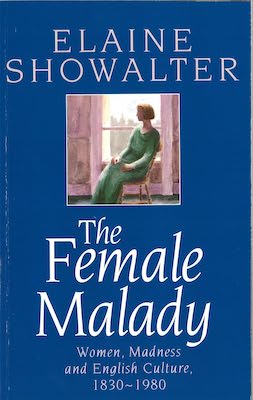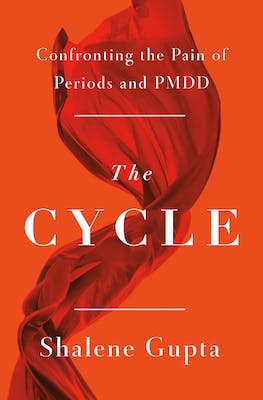When I started writing my memoir, The Cycle, about being diagnosed with Premenstrual dysphoric disorder (PMDD), I had rarely seen periods in literature, much less PMDD, with the exception of some health textbooks. In fact, my entire understanding of what a period was supposed to be like was shaped by a resounding silence. Periods happen off of the page, out of sight, and out of mind. If I went solely by literature, it’d be easy to believe most people didn’t have periods.
I only realized I had a debilitating condition when I was in my thirties, because I had no idea what a normal period was like. Normal was what my body was going through—I had no idea what other people’s bodies went through. Still, I shied away from reading up on periods and PMDD. I wasn’t sure I wanted to dive into books assuring me that my body was nature’s blessing, or medical tomes that lulled me to sleep. When I finally took the plunge, I found a small but excellent ecosystem of books—and I realized, they had to be. Breaking through the stone walls of stigma, doesn’t just require getting past gatekeepers, it also means being compelling enough to keep audiences turning the page even if they shy away from the subject material. All of these books on this list have broken through the stone walls of stigma. They are explosive in their originality and jewel-like in their brilliance.
It’s Not Hysteria by Dr. Karen Tang
Dr. Tang is the gynecologist we all deserve. It’s Not Hysteria is an easy-to-understand guide to gynecology, written in witty, accessible language. (For instance, fallopian tubes are described as “corridors from the ovaries to the uterus.”) She writes from an inclusive lens, covering gender identities, with care and threading BIPOC history and studies through her narrative. Tang walks the reader through the most common reproductive health issues and treatment options, while providing tips for how to discuss them with your doctor. If you’ve ever had a question about your cycle or how your plumbing works, the answer is probably in It’s Not Hysteria.
Periods Gone Public by Jennifer Weiss Wolf
Periods Gone Public is a thoroughly researched history of menstrual stigma and the ways in which this stigma punishes menstruators. Children end up missing class, adults end up missing work, and the incarcerated struggle to stay clean and thus healthy. Weiss-Wolf managed to combine a strident call to action with a bubbly upbeat tone that simultaneously convinces the reader there’s a huge problem, but we’re all going to get up and do something to fix it.
Period Power by Nadya Okamoto
Okamoto wrote Period Power as an undergraduate Harvard. She shines the spotlight on period poverty, showing how our reluctance to talk about menstruation leads to a reluctance to provide solutions for managing them. This, of course, hits people at the bottom of the economic pyramid the hardest. In clear, chatty prose, Okamoto combines a socioeconomic overview of periods with her own experience of dealing with her period while her family struggled with homelessness. Period Power will make you rage over the tampon tax, and ask the questions we don’t ask in society: What happens to people who can’t afford period products? What do we need to do create a better world for menstruators?
Red Hood by Elana K. Arnold
When 16-year-old Bisou gets her first period, she runs into the woods and is attacked by a wolf. Desperate, she breaks its neck. The next morning, the body of one of her classmates is found in the woods. In this dark retelling of Little Red Riding Hood, sexual predators turn into wolves, and menstruation gives Bisou power to kill them. Red Hood is more than a new take on an old fairytale, it lays out a vision of the world where puberty and female friendship allow women to fight back against the patriarchy instead of become prey.
The Red Zone by Chloe Caldwell
Chloe Caldwell’s period has always been painful and inconvenient, but it reaches a fever pitch when she falls for musician Tony. With spare prose and off-the-wall structure, Caldwell’s memoir recounts the fights, the break downs, and the break ups that punctuate life with PMDD. She layers in a collage of other voices reflecting on first periods, their own PMDD battles, and what it’s like to find community at a PMDD conference. Chloe Caldwell manages to make PMDD, an epically uncool disorder, seem glamorous and chic. The Red Zone combines a period memoir with a meditation on divorce, marriage, and the perils of love.
The Society for Shame by Jane Roper
When Kathleen Held discovers her husband is cheating, she’s not sure which is worse—his betrayal, or being photographed with a giant period stain on her pants. Kathleen is catapulted into internet fame that she did not ask for and did not want. She finds the society for shame, a group of people who have been cancelled online, and decides to “steer into the swerve” and make her new fame work for her. But Katheen discovers that fame can be a double-edged sword, and the fame that made her a household name might also cost her everything she holds dear. The Society for Shame goes down as easy as a beach read, while being a searing commentary on period stigma, and the pitfalls of social media fame.

The Female Malady by Elaine Showalter
Showalter’s classic feminist analysis isn’t strictly about periods, it’s about how superstitions around periods throughout history shaped the modern perception of women being “crazy”. She traces the major trends in psychiatry, sexist policy reforms that barred women from providing mental health care, and the stifling restrictions placed upon women after the onset of menarche. The Female Malady shows how these factors converged to create a society that assumed women were mad because they bled, while simultaneously fostering an environment that incubated depression and anxiety.

























































